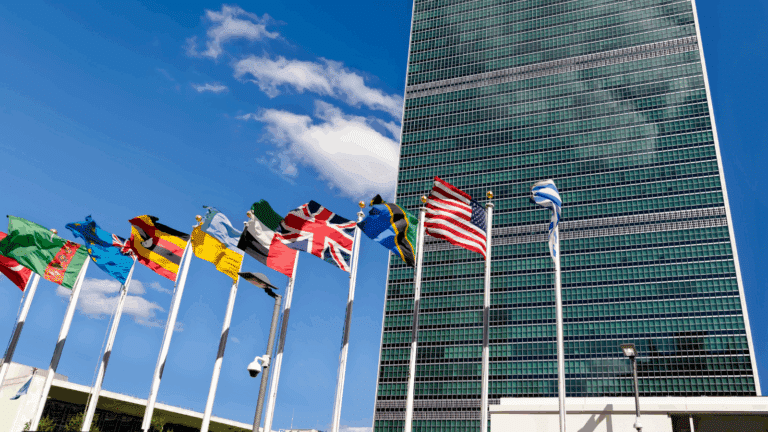India’s national statement at COP26 in Glasgow, presented by Prime Minister Narendra Modi on Nov. 1, is more aggressive in its goals than the intended nationally determined contribution (NDC) the country submitted in 2015. Although India has yet to formally submit the new NDCs and details of the commitments in terms of the baseline and reductions, the statement itself provides an indication of the strategy India is likely to adopt in its energy transition.
India is the third-largest carbon dioxide (CO2) emitter globally and accounted for 7 percent of global emissions in 2020.[1] China is the world’s largest emitter, releasing nearly five times more greenhouse gases than India, followed by the US, which emits almost twice as much.[2] According to the International Energy Agency’s World Energy Outlook 2021 (IEA’s WEO), India’s emissions are likely to grow the fastest among the major global economies and, unlike China and the US, its emissions are not expected to peak in the next three decades. As a result, India’s share of annual global emissions is expected to rise to 9 percent by 2030 and 11 percent by 2050.[3] Coming into COP26, India had been one of the last remaining G20 countries to not commit to a net-zero carbon emissions target. This changed when Modi announced at COP26 that India will reach net-zero emissions by 2070.
In this piece, the Center on Global Energy Policy’s Kaushik Deb, senior research scholar, and Mahak Agrawal, staff associate II, answer key questions about India’s new climate commitments.
Q. What did India commit to in the national statement at COP26?
A. In its national statement, India announced five targets (labelled Panchamrit, the so-called ”nectars for immortality”):[4]
- Increase its non-fossil electricity generation capacity to 500 GW by 2030, from 155 GW today.
- Meet 50 percent of its energy requirements from renewable energy by 2030.
- Reduce the total projected carbon emissions by one billion tons from 2021 till 2030. The IEA’s WEO estimated India’s CO2 emissions from energy use at 2.3 billion tons in 2020.
- Reduce its economy’s carbon intensity by 45 percent by 2030, compared to 2005 levels.
- Achieve the target of net-zero carbon emissions by 2070.
There was no reference to one of the goals in the 2015 NDC: “to create an additional carbon sink of 2.5 to 3 billion tons of CO2 equivalent through additional forest and tree cover by 2030.” This is one target in its NDC that India has struggled to meet, with the rate for afforestation not keeping up with the ambition.[5]
Q. How ambitious are India’s new targets?
A. Non-fossil electricity generation capacity of 500 GW by 2030.
The previous target, announced in 2019,[6] was 450 GW of non-fossil electricity generation by 2030, which itself was higher than the original target of 175 GW, though by 2022, in India’s first NDC in 2015.[7] For comparison, the current non-fossil generation capacity stands at 155 GW, out of which 102 GW is renewable energy.[8]
Energy requirements from renewable energy by 2030.
Renewable energy currently meets just 4.5 percent of India’s total energy needs,[9] so increasing that level to 50 percent by 2030 would be a remarkable jump. Even at current levels of energy consumption, without accounting for any growth, renewable energy generation will have to increase by over a factor of 11, or 27 percent per annum for the rest of the decade, to reach that target.
Even meeting 50 percent of its electricity (instead of total energy) demand from renewable sources would require an increase of over 5 times today’s renewable electricity generation just to meet current demand.
Needless to say, it is difficult to assess the magnitude of this challenge until the details of the final, formal NDC submission are released. For example, if this metric is analogous to one of the targets in India’s previous NDC—“to achieve about 40 percent cumulative electric power installed capacity from non-fossil fuel-based energy resources by 2030”—the target is much more easily achieved and the impact on GHG emissions would be muted. Renewables already account for nearly 26 percent of total electricity generation capacity in India,[10] of which 44 percent is being sourced from solar power, 40 percent from wind power, 11 percent from bio-power, and 5 percent from small-hydro.[11]
Reduce emissions by one billion tons from 2021 till 2030.
One billion tons accounts for 43 percent of India’s present annual emissions.[12] As noteworthy as this reduction could be for India, it represents just 3 percent of annual global emissions. Currently, the US emits twice as much GHG as India, and China emits four times more.
Reduce its economy’s carbon intensity by 45 percent by 2030, compared to 2005 levels.
In the 2015 NDC, India pledged to reduce the emissions intensity of its GDP by 33–35 percent by 2030 from 2005 levels. Using real GDP data from the International Monetary Fund and CO2 emissions reported in the BP Statistical Review of World Energy 2021, we estimate that India’s emissions intensity in 2020 was already 22 percent lower than 2005 levels, declining by 2 percent per annum since then. If the emissions intensity continues to decline at this rate, India is well on its way to achieving the 2015 NDC target.
Net-zero by 2070.
India’s new goal of achieving net-zero GHG emissions by 2070 was a much-discussed element of the national statement at COP26, as the nation was one of the very few countries in the G20 that had not committed to a net-zero target before Glasgow. As with other countries that have made similar announcements, the government has not yet released details of a roadmap to net-zero. Noteworthy, though, is that among the top 20 GHG emitters globally, India’s net-zero target is at least a decade later than any other country’s announced target.
Are India’s new targets realistic?
- Other than the 2070 net-zero announcement, the overwhelming majority of the targets are in the renewable energy sector for 2030. India’s renewable energy generation capacity has already been growing at 22 percent per annum since 2015.[13] Increasing non-fossil generation capacity to 500 GW by 2030 implies annual growth of 14 percent from now until 2030, so, barring other factors, this goal may be achievable.
- India has also achieved an 18 percent annual growth in renewable energy generation since 2015.[14] If overall electricity demand continues to grow at the current rate of 3.4 percent per annum, renewable generation would need to grow by 22 percent per annum by 2030 for renewables to meet 50 percent of electricity demand.
- As mentioned earlier, assessing achievement and progress on the target of reducing emissions by one billion tons depends on the fine print of the NDC, specifically the definition of a baseline and how this reduction is accounted for. Depending on how India defines its baseline for measuring the reduction in emissions, this could be a significant contribution from India toward maintaining the global carbon budget.
- As far as the target to reduce emissions intensity by 45 percent relative to 2005 levels by 2030, the COP26 commitment has raised the bar and would require emissions intensity to fall by 3.4 percent per annum until 2030.
- Compared to the 2030 targets, the net-zero target for 2070 gives India more time to plan a roadmap to achieve a net-zero outcome. However, one issue that would remain central to a grid dominated by renewables is the need for an alternative to balance the intermittency of renewable electricity generation. In India today, that flexibility is provided by coal, and unless emissions from coal-based generation are managed, achieving a net-zero outcome would become more difficult. The proposed increase in renewables capacity in the next decade would also have implications for existing and proposed coal-based power plants, adding to the financial woes of the power sector, particularly the accumulated financial liabilities of India’s distribution companies, as other commentators have noted.[15]
Q. What else did India discuss at COP26 that could be relevant for future decarbonization efforts?
A. Apart from the NDC commitments outlined in the national statement, India was active in a number of other initiatives during COP26.
Prime Minister Modi’s speech outlining India’s COP26 commitments were prefaced with a call for a “mass movement” of environmentally conscious living, labelled LIFE: Lifestyle for Environment. This includes mindful and deliberate utilization of resources across the diverse sectors of fishing, agriculture, wellness, dietary choices, packaging, housing, hospitality, tourism, clothing, fashion, water management, and energy.
In addition, India called on the group Like-Minded Developing Countries (LMDC) to negotiate to preserve and strengthen the interests of LMDC in the fight against climate change. With the participation of China, Cuba, Venezuela, and Nicaragua, India urged developed countries to make available at least $1 trillion in climate finance, arguing that support to developing countries at the levels decided in 2009 are not adequate to meet climate goals.
India and the UK also launched the Green Grids Initiative – One Sun One World One Grid, backed by 80 countries, to “dramatically accelerate” the global transition to clean energy. This initiative appears to be a continuation of the One Sun One World One Grid initiative that was launched with a tripartite memorandum of understanding among the International Solar Alliance, the World Bank, and the government of India on September 8, 2020.[16] This 2020 initiative envisioned interconnecting loads and generators across continents with an international power transmission grid supplied with solar power that taps differential availability of sunshine in different countries at different times.
The Infrastructure for Resilient Island States initiative, which India is leading, was also launched at COP26, with a vision to help small island developing states facing the risk of floods and cyclones.[17] For now, this appears to be more of a knowledge-sharing platform than helping finance adaptation in small island states.
India also signed up for the UK-led Glasgow global Breakthrough Agenda, which provides a framework for countries and businesses to take action to keep the 1.5°C maximum-temperature-rise target alive by reducing global emissions by half by 2030.[18] The agenda aims to scale and expand clean energy options while making them affordable, accessible, and attractive across all sectors by 2030, focusing on power, steel, road transport, hydrogen, and agriculture—which together account for more than half of global emissions.[19] Importantly, the signatories to this framework have agreed to measure progress annually through a “State of the Transition” report, assessing global progress and identifying opportunities for further international coordination gains.
Notes




